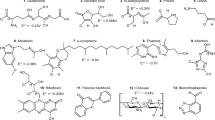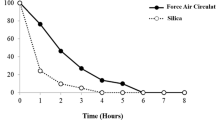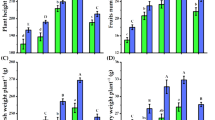Abstract
Galerucella placida Baly feeds on the rice-field weed Polygonum orientale L. (Polygonaceae) in India and Bangladesh during autumn and winter seasons. The insect is widely available during the winter season when the temperature fluctuates between 9 and 24 °C. Hence, it is of considerable interest to study how the adults cope with the stress resulting due to temperature fluctuations. Consequently, we analysed the levels of H2O2, antioxidant enzymes [catalase (CAT), superoxide dismutase (SOD), peroxidases (POD), guaiacol peroxidase (GPX), pyrogallol peroxidases (PPX), ascorbate peroxidases (APOX) and glutathione-S-transferases (GST)] and malondialdehyde (MDA) at 9,12,15,18, 21 and 24 °C in adult G. placida. H2O2 was highest at 24 °C followed by 9 °C and lowest at 18 and 21°C. CAT and SOD were highest at 9 °C followed by 24 °C, while POD was highest at 24 °C followed by 9 °C. CAT and POD were lowest at 18 and 21 °C, but SOD was the lowest at 21 °C. APOX were three-fold higher at 9 °C compared to 12 °C, which was the lowest at 18 and 21 °C, implying that APOX had strong detoxification function at 9 °C. GST was highest and lowest at 9 and 21 °C, respectively. MDA was highest at 9 °C and lowest at 18 and 21 °C, which did not differ significantly at 15 and 24 °C, suggesting that lower and higher temperature stress was accompanied by lipid peroxidation. This finding provides useful information for mass rearing of G. placida for predicting population dynamics and understanding the potential for G. placida as biocontrol agent under varying environmental conditions.
Similar content being viewed by others
References
Ahmad S. and Pardini R. S. (1990) Mechanisms for regulating oxygen toxicity in phytophagous insects. Free Radical Biology and Medicine 8, 401–413.
Ahmad S., Duval D. L., Weinhold L. C. and Pardini R. S. (1991) Cabbage looper antioxidant enzymes: Tissue specificity. Insect Biochemistry 21, 563–572.
Ali A., Rashid M. A., Huang Q. Y., Wong C. and Lei C. L. (2017) Response of antioxidant enzymes in Mythimna separata (Lepidoptera: Noctuidae) exposed to thermal stress. Bulletin of Entomological Research 107, 382–390.
An M. I. and Choi C. Y. (2010) Activity of antioxidant enzymes and physiological responses in ark shell, Scapharca broughtonii, exposed to thermal and osmotic stress: Effects on hemolymph and biochemical parameters. Comparative Biochemistry and Physiology Part B: Biochemistry & Molecular Biology 155, 34–42.
Apel K. and Hirt H. (2004) Reactive oxygen species: Metabolism, oxidative stress, and signal transduction. Annual Review of Plant Biology 55, 373–399.
Bale J. S., Masters G.J., Hodkinson I. D., Awmack C., Bezemer T. M., Brown V. K., Butterfield J., Buse A., Coulson J. C., Farrar J., Good J. E. G., Harrington R., Hartley S., Jones T. H., Lindroth R. L., Press M. C., Symrnioudis I., Watt A. D. and Whittaker J. B. (2002) Herbivory in global climate change research: Direct effects of rising temperature on insect herbivores. Global Change Biology 8, 1–16.
Baly J. S. (1878) Descriptions of the phytophagous Coleoptera collected by the late Dr. F. Stoliczka during Forsyth’s Expedition to Kashgar in 1873–1874. Cistula Entomologica 2, 369–383.
Barbehenn R. V. (2002) Gut-based antioxidant enzymes in a polyphagous and a graminivorous grasshopper. Journal of Chemical Ecology 28, 1329–1347.
Beenen R. (1998) Galerucella placida a proper species from south east Asia (Coleoptera: Chrysomelidae: Galerucinae). Serangga 3, 107–110.
Board P. G. and Menon D. (2013) Glutathione transferases, regulators of cellular metabolism and physiology. Biochimica et Biophysica Acta 1830, 3267–3288.
Bradford M. M. (1976) A rapid and sensitive method for the quantitation of microgram quantities of protein utilizing the principle of protein-dye binding. Analytical Biochemistry 72, 248–254.
Celino F. T., Yamaguchi S., Miura C., Ohta T., Tozawa Y., Iwai T. and Miura T. (2011) Tolerance of spermatogonia to oxidative stress is due to high levels of Zn and Cu/Zn superoxide dismutase. PLoS ONE 6, e16938.
Claravon-Mathews M., Summers C. B. and Felton G. W. (1997) Ascorbate peroxidase: A novel antioxidant enzyme in insects. Archives of Insect Biochemistry and Physiology 34, 57–68.
Del Rio D., Stewart A. J. and Pellegrini N. (2005) A review of recent studies on malondialdehyde as toxic molecule and biological marker of oxidative stress. Nutrition, Metabolism and Cardiovascular Diseases 15, 316–328.
Ding J., Fu W., Reardon R., Wu Y. and Zhang G. (2004) Exploratory survey in China for potential insect biocontrol agents of mile-a-minute weed, Polygonum perfoliatum L., in Eastern USA. Biological Control 30, 487–495.
Dubovskiy I. M., Martemyanov V. V., Vorontsova Y. L., Rantala M. J., Gryzanova E. V. and Glupov V. V. (2008) Effect of bacterial infection on antioxidant activity and lipid peroxidation in the midgut of Galleria mellonella L. larvae (Lepidoptera, Pyralidae). Comparative Biochemistry and Physiology Part C: Toxicology & Pharmacology 148, 1–5.
Felton G. W. and Summers C. B. (1995) Antioxidant systems in insects. Archives of Insect Biochemistry and Physiology 29, 187–197.
Giannopolitis C. N. and Ries S. K. (1977) Superoxide dismutase. I. Occurrence in higher plants. Plant Physiology 59, 309–314.
Habig W. H., Pabst M. J. and Jakoby W. B. (1974) Glutathione S-transferases. The first enzymatic step in mercapturic acid formation. Journal of Biological Chemistry 249, 7130–7139.
Heath R. L. and Packer L. (1968) Photoperoxidation in isolated chloroplasts. I. Kinetics and stoichiometry of fatty acid peroxidation. Archives of Biochemistry and Biophysics 125, 189–198.
Hnatiuk R. J. (1990) Census of Australian Vascular Plants. Australian Flora and Fauna Series Number 11. Australian Government Publishing Service, Canberra. 650 pp.
Howe G. A. and Schilmiller A. L. (2002) Oxylipin metabolism in response to stress. Current Opinion in Plant Biology 5, 230–236.
Jena K., Kar P. K., Kausar Z. and Babu C. S. (2013) Effects of temperature on modulation of oxidative stress and antioxidant defenses in testes of tropical tasar silkworm Antheraea mylitta. Journal of Thermal Biology 38, 199–204.
Jia F. X., Dou W., Hu F. and Wang J. J. (2011) Effects of thermal stress on lipid peroxidation and antioxidant enzyme activities of oriental fruit fly, Bactrocera dorsalis (Diptera: Tephritidae). Florida Entomologist 94, 956–963.
Kar M. and Mishra D. (1976) Catalase, peroxidase and polyphenoloxidase activities during rice leaf senescence. Plant Physiology 57, 315–319.
Kimoto S. (1989) Chrysomelidae (Coleoptera) of Thailand, Cambodia, Laos and Vietnam. IV. Galerucinae. Esakia 27, 1–241.
Korayem A. M., Khodairy M. M., Abdel-Aal A. A. and El-Sonbaty A. A. M. (2012) The protective strategy of antioxidant enzymes against hydrogen peroxide in honey bee, Apis mellifera during two different seasons. Journal of Biology and Earth Sciences 2, B93–B109.
Le Bras S. and Echaubard M. (1977) Variations quantitatives des proteines dans les tissus de la mouche domestique (Musca domestica L.) au cours de la vie imaginale, l. Apres intoxication par l’Hempa. Bulletin la Société Zoologique de France 102, 95–106.
Lijun L., Xuemei L., Yaping G. and Enbo M. (2005) Activity of the enzymes of the antioxidative system in cadmium-treated Oxya chinensis (Orthoptera: Acridoidae). Environmental Toxicology and Pharmacology 20, 412–416.
Lopez-Martinez G., Elnitsky M. A., Benoit J. B., Lee Jr R. E. and Denlinger D. L. (2008) High resistance to oxidative damage in the Antarctic midge Belgica antarctica, and developmentally linked expression of genes encoding superoxide dismutase, catalase and heat shock proteins. Insect Biochemistry and Molecular Biology 38, 796–804.
MacNevin W. M. and Urone P. F. (1953) Separation of hydrogen peroxide from organic hydroperoxides. Analytical Chemistry 25, 1760–1761.
Maehly A. C. and Chance B. (1954) The assay of catalases and peroxidases, pp. 357–424. In Methods of Biochemical Analysis (edited by D. Glick). Interscience, New York.
Mai V. C., Tran N. T. and Nguyen D. S. (2016) The involvement of peroxidases in soybean seedlings’ defense against infestation of cowpea aphid. Arthropod-Plant Interactions 10, 283–292.
Malik U. and Barik A. (2015) Free fatty acids from the weed, Polygonum orientale leaves for attraction of the potential biocontrol agent, Galerucella placida (Coleoptera: Chrysomelidae). Biocontrol Science and Technology 25, 593–607.
Malik U., Das S. and Barik A. (2016a) Biology of Galerucella placida Baly (Coleoptera: Chrysomelidae) on the ricefield weed Polygonum orientale L. (Polygonaceae). Proceedings of the Zoological Society. doi.10.1007/s12595-016-0203-x.
Malik U., Karmakar A. and Barik A. (2016b) Attraction of the potential biocontrol agent GaleruceUa placida (Coleoptera: Chrysomelidae) to the volatiles of Polygonum orientale (Polygonaceae) weed leaves. Chemoecology 26, 45–58.
Malik U., Mitra S. and Barik A. (2017) Attraction of the biocontrol agent, Galerucella placida Baly (Coleoptera: Chrysomelidae) to the leaf surface alkanes of the weed, Polygonum orientale L. Allelopathy Journal 40, 103–116.
Marutani-Hert M., Hunter W. B. and Hall D. G. (2010) Gene response to stress in the Asian citrus psyllid (Hemiptera: Psyllidae). Florida Entomologist 93, 519–525.
Maulik S. (1936) The Fauna of British India, Including Ceylon and Burma. Coleoptera. Chrysomelidae (Galerucinae). Taylor and Francis, London. 648 pp.
Meng J. Y., Zhang C. Y., Zhu F., Wang X. P. and Lei C. L. (2009) Ultraviolet light-induced oxidative stress: Effects on antioxidant response of Helicoverpa armigera adults. Journal of Insect Physiology 55, 588–592.
Monteiro D. A., de Almeida J. A., Rantin F. T. and Kalinin A. L. (2006) Oxidative stress biomarkers in the freshwater characid fish, Brycon cephalus, exposed to organophosphorus insecticide Folisuper 600 (methyl parathion). Comparative Biochemistry and Physiology Part C: Toxicology & Pharmacology 143, 141–149.
Nabizadeh P. and Kumar T. S. J. (2011) Fat body catalase activity as a biochemical index for the recognition of thermotolerant breeds of mulberry silkworm, Bombyx mori L. Journal of Thermal Biology 36, 1–6.
Nakano Y. and Asada K. (1981) Hydrogen peroxide is scavenged by ascorbate-specific peroxidase in spinach chloroplasts. Plant and Cell Physiology 22, 867–880.
Paital B., Panda S. K., Hati A. K., Mohanty B., Mohapatra M. K., Kanungo S. and Chainy G. B. N. (2016) Longevity of animals under reactive oxygen species stress and disease susceptibility due to global warming. World Journal of Biological Chemistry 7, 110–127.
Reid C. A. M. (2001) Galerucella placida Baly in Australia (Coleoptera: Chrysomelidae: Galerucinae). Australian Journal of Entomology 40, 331–334.
Sarkar N. and Barik A. (2017) Effect of temperature on development and reproduction of Epilachna dodecastigma (Wied.) (Coleoptera: Coccinellidae). Proceedings of the Zoological Society 70, 150–155.
Snell F. D. and Snell C. T. (1971) Colorimetric Methods of Analysis. Van Nostrand Reinhold Co., New York. 622 pp.
Sohal R. S., Arnold L. and Orr W. C. (1990) Effect of age on superoxide dismutase, catalase, glutathione reductase, inorganic peroxides, TBA-reactive material, GSH/GSSG, NADPH/NADP+ and NADH/NAD+ in Drosophila melanogaster. Mechanisms of Ageing and Development 56, 223–235.
Storey K. B. and Storey J. M. (2010) Oxygen: Stress and adaptation in cold-hardy insects, pp. 141–165. In Low Temperature Biology of Insects (edited by D. L. Denlinger and R. E. Lee Jr). Cambridge University Press, New York.
Wang Y., Oberley L. W. and Murhammer D. W. (2001) Antioxidant defense systems of two lepidopteran insect cell lines. Free Radical Biology and Medicine 30, 1254–1262.
Yang L. H., Huang H. and Wang J. J. (2010) Antioxidant responses of citrus red mite, Panonychus citri (McGregor) (Acari: Tetranychidae), exposed to thermal stress. Journal of Insect Physiology 56, 1871–1876.
Zar J. H. (1999) Biostatistical Analysis. Prentice Hall, New Jersey. 929 pp.
Zhang G. H., Liu H., Wang J. J. and Wang Z. Y. (2014) Effects of thermal stress on lipid peroxidation and antioxidant enzyme activities of the predatory mite, Neoseiulus cucumeris (Acari: Phytoseiidae). Experimental and Applied Acarology 64, 73–85.
Zhang S., Fu W., Li N., Zhang F. and Liu T. X. (2015) Antioxidant responses of Propylaea japonica (Coleoptera: Coccinellidae) exposed to high temperature stress. Journal of Insect Physiology 73, 47–52.
Author information
Authors and Affiliations
Corresponding author
Rights and permissions
About this article
Cite this article
Das, S., Malik, U. & Barik, A. Effect of thermal stress on antioxidant responses of the biocontrol agent Galerucella placida (Coleoptera: Chrysomelidae). Int J Trop Insect Sci 38, 400–409 (2018). https://doi.org/10.1017/S1742758418000218
Accepted:
Published:
Issue Date:
DOI: https://doi.org/10.1017/S1742758418000218




